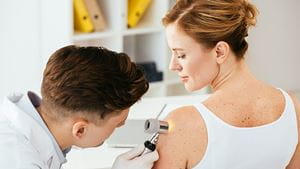
The American Cancer Society estimates approximately 97,610 people in the U.S. will be diagnosed with melanoma in 2023. Nearly 8,000 people are expected to die each year of melanoma.
As the fifth most common cancer among men and sixth most common cancer among women, melanoma affects a significant number of people each year.
Gian Vinelli, MD, is a dermatologist and Mohs micrographic surgeon with Rochester Regional Health, and explains you can reduce your risk of getting skin cancer.
Compared to other skin cancers, melanoma has a significantly greater chance of being fatal. Because of its ability to travel to other parts of the body, early detection can save your life.
While melanoma can be fatal, patients can prevent the disease by minimizing their exposure to harmful UV rays. Melanoma is also detectable through frequent self-exams and screenings by credentialed physicians.
Both environmental and genetic factors affect a person’s likelihood of developing melanoma, such as:
“A single blistering sunburn can more than double your risk of developing melanoma,” Dr. Vinelli said.
Despite the popularity of indoor tanning, there is no safe version. Even if a person develops a tan, having one will not protect them from sunburn. There is no industry standard for their use, strength or maintenance.
Studies from the Journal of the American Academy of Dermatology show as many as 70 percent of people exceed the maximum recommended exposure when they use a tanning bed.
Choosing to use a tanning bed before the age of 20 is linked to a nearly 50 percent increase in a person’s risk of developing melanoma. While New York prohibits individuals under the age of 18 from using indoor tanning beds, the knowledge that it can still cause harm can be helpful in reducing the risk of developing melanoma.
Another cause for concern with melanoma is the presence of moles.
If a person develops moles that grow quickly or change shape, size, or color in an unusual way, contacting a dermatologist will help determine whether they are a potential problem.
“We are available to answer any questions about areas of concern, especially when it comes to problems that could lead to life-threatening health consequences,” Dr. Vinelli said. “Reach out to a provider to set up a screening and learn more.”